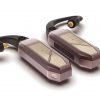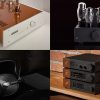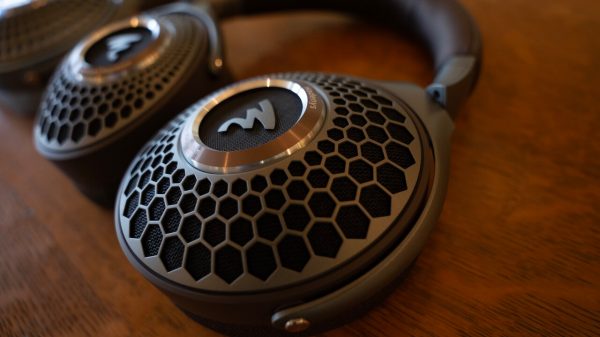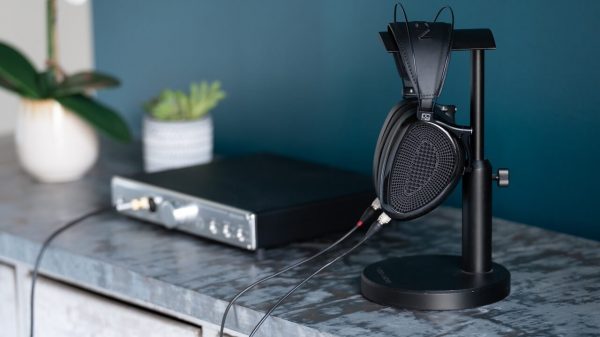Timing is everything sometimes. Having survived two years of turmoil caused by a global pandemic, Meze Audio was feeling cautiously optimistic about the future in February 2022. With new products like the Meze Audio ELITE, ADVAR, and LIRIC entering the market and a flourish of positive press, Antonio Meze and his team were pushing forward in the post-pandemic world.
Every company in the industry has been forced to contend with supply chain and shipping issues, but nobody could foresee the looming bear over the horizon less than an hour from Meze’s corporate headquarters and over the skies of its technology partner in Lviv. War is never good for business when you are in the business of turning swords into the world’s best headphones.
Started in 2009, Meze Audio began its journey into the world of headphones in Baia Mare, Romania; a city of 136,000 people located less than thirty miles from the border with Ukraine.
The creation of a new middle class fueled demand for western consumer goods, but more importantly, led to investment in domestic start-ups who have proven capable of competing with well-established brands from America, Western Europe, and Asia. Companies like Meze Audio who have exceeded every possible expectation.

Over the past two years, I have had the opportunity to review several of the Meze Audio products ranging from the budget beating 12 Classics V2 IEMs, 99 Classics, Rai Penta, LIRIC, and the flagship Empyrean and ADVAR models.
When the opportunity to review the ELITE came across my desk courtesy of Todd the Vinyl Junkie, I grasped it with both hands because I wanted to do a comprehensive comparison to the Audeze LCD-5 which is its main competitor in the high-end headphone category.
Shopping for record sleeves and enzyme cleaner for my record collection, I discovered his online store and highly recommend him for both headphones, and vinyl-related products based on my experience so far.

The Skinny
The Meze ELITE is not a replacement for the Empyrean which still sits in the lineup and continues to sell well; it remains a world class headphone and one of the best to come out of the Head-Fi revolution over the past decade.
The two models do share some similarities but three years of R&D work on the newer version of the Rinaro IsoPlanar driver put some distance between them. Many of the best features of the Empyrean have been refined on the ELITE and it was very interesting to compare the two.
On a visual level, the two headphones do look very similar, and one could be forgiven for thinking that the ELITE was an Empyrean with a new black and silver finish. Both headphones ship in aluminum hard cases; the ELITE’s case has a raw aluminum finish, and the Empyrean comes in an anodized black case.
Both share the same basic ear cup and gimbal design and somewhat similar suspensions. The headband of the ELITE is manufactured from carbon fiber to help reduce the already lightweight design, and the suspension has been reshaped to improve the weight distribution on your head; Meze have since patented the design.

The ear cups still retain the same basic shape and the magnetically attached pads are still part of the design; the ear pads on the ELITE now function in a similar manner as the pads now offered on the LIRIC, which are designed to act as part of the sound chamber and extension of the driver.
The ELITE ship with 30mm Alcantara pads and 25mm perforated Alcantara pads that offer greater air flow and a slightly different sounding signature. You can use older Empyrean pads if you prefer the style and temperature, but they will alter the sonic signature of the headphones.
The Meze ELITE utilize planar magnetic driver technology and while they share some technical similarities to other planar drivers used by Audeze, Dan Clark Audio, and HiFiMAN, there are some very unique features that differentiate them in a rather significant way.
Rinaro have designed a hybrid Iso-Dynamic Array for the ELITE; the planar magnetic driver has two different trace patterns laid out in specific areas to better direct sound to your ears. The top portion of the driver is a curved switchback that looks somewhat like a winding mountain road.
This region is responsible for producing the lowest part of the frequency range; the lower portion is a circular trace and handles the midrange and treble.
The lower portion of the driver lines up with the ear canal because shorter wavelengths diffuse more rapidly than lower frequencies. This minimizes the distance the midrange and treble information travel between the face of the driver and the ear drum; the intended result is better clarity and more defined imaging.
The driver material has also changed with the ELITE; the diaphragm is now constructed from a material called Parus that is both thinner and lighter. The rationale for the change was that Parus further improves the speed of the driver; the Empyrean was already state-of-the-art in that regard and the new driver is apparently stronger and capable of greater longevity.
Meze have packaged the ELITE with an OFC cable with a nylon outer casing and several length options and connection types which you need to select when purchasing.

All of the cables are made from the same materials but you have the option of 6.35mm or XLR for desktop amplifiers or a 3.5mm termination when traveling with a DAP or smartphone/Dongle DAC combination.
The only missing option is a 2.5mm or 4.4mm lightweight version for portable use. The good news is that the mini-XLR connections used at the cups are common and a number of aftermarket or upgrade options exist in the market for them.
Sound
The ELITE are 430 grams which makes them only marginally heavier than the Audeze LCD-5, and 60 grams lighter than the Focal Utopia; weight is certainly a factor for a lot of buyers in the $3,000 to $4,000 price range. The Dan Clark Audio Stealth weigh only 410 grams which makes them the lightest of the ultra high-end models.
Comparing the ELITE to Empyrean, I found the newer model to be slightly more comfortable because of the weight distribution and the perforated pads that felt cooler on my head during long listening sessions. I do listen outside in the summer in Tennessee with my DAPs and the heat can become oppressive. The lighter pads certainly made a difference.

Looking back at my listening notes, there were some distinct sonic differences depending on which ear pads were used; the thinner perforated pads resulted in less bass impact in comparison to the solid pads and I found the midrange and treble to have more emphasis and detail.
The thinner pads were preferable when listening to strings and vocals, and I found the solid pads to be better with classic rock, EDM, and bass heavy music. The differences between the two pads are not subtle which makes the magnetized attachment a rather handy feature.
If you are in the market for a pair of headphones in this price range, sound quality has to be the defining factor and the ELITE do not alone at the top of the mountain in the category.

When the Meze Empyrean were first introduced, many felt that they were the best headphones available and others in the Head-Fi community found them to be quite divisive in that regard.
There is a distinct sonic signature and those who prefer a warmer sounding pair of headphones that are not a clinical sounding reference will find a lot to love about the Empyrean; EIC Ian White demurs and feels that the Empyrean are one of the finest headphones ever made offering a level of musical engagement that few other headphones offer. He also sits squarely in the “accuracy is overrated” when it comes to headphones camp. YMMV.
The Empyrean and ELITE do share a lot of design similarities but they certainly do not sound the same; Meze have taken all of the best sonic features and enhanced them, and fixed a number of issues that made potential buyers consider the Audeze LCD-5 and Dan Clark Audio Stealth instead.
The ELITE is not for bass heads, but the extreme low end has very good presence and the roll-off is only notable around 20Hz. The driver is very quick and it allows the headphone to deliver bass that is detailed, articulate, and with very good texture.
There is zero excess energy or bleed into the upper bass or lower midrange; which is an audible improvement over the Empyrean which did suffer from some excess bloom that impacted the overall impact and clarity in the bass.
The midrange is very linear sounding and I could not discern any impact from the upper bass on the overall clarity of the sound. Texture and detail retrieval are excellent in this range and I want to applaud Meze for not making the decision to boost the upper midrange; a practice that has become rather commonplace with other manufacturers in 2022.
Male vocals have some added weight but are not pushed forward of the instrumentation; the same situation applies to female vocalists who have just enough texture, detail, and presence to stand out. Meze tends to favor a slightly restrained presentation with their headphones and earphones and that is the case here as well with the ELITE. Everything sounds very natural with rather accurate timbre and detail.
The highs start with a mild degree of lift in the upper midrange that plateaus and falls back slightly in the mid-treble (5kHz to 9kHz), which keeps the ELITE from becoming fatiguing during long listening sessions.
The upper treble does add back some energy which addresses one of the complaints about the Empyrean; a lack of airiness or sparkle in the top end to open up the sound somewhat. This change helps with the crispness of percussion; snare rattle and cymbals sound more natural on almost every recording and there is more obvious decay as the notes fade.
Overall, the Meze ELITE has a frequency response that mirrors the Harman Curve rather accurately from 1kHz down, and at about -3dB from about 1kHz upward.
It is a more open sounding headphone than the Empyrean with better detail, bass response, and transparency.
The soundstage and imaging are a definite improvement over the Empyrean; everything sounds wider and deeper with a marginal improvement in height. Stereo separation is excellent and i was able to accurately place most instruments in the orchestra on the stage. The imaging is some of the best I’ve heard from a planar magnetic headphone; everything is carved very firmly in its proper place and there is accurate depth with most recordings.
Even the most complex orchestral recordings sound very precise and layered; instruments are where they should be and there is very little crossover on the stage.

ELITE Versus?
There is a lot of competition in the $3000 to $4,000 segment and the Meze ELITE actually faces some rather stiff competition in that range; the Meze Empyrean, Audeze LCD-5, HiFiMAN HE1000SE, Dan Clark Audio Stealth, Final Audio 8000, and Focal Utopia all offer state-of-the-art performance and should be on your audition list if your wallet allows for it.
I have already detailed the differences between the ELITE and the Empyrean, and while the two models utilize different drivers, they both share nearly identical specs (32 ohms vs 31.6 ohms and 100dB/mW vs 101dB/mW) so drivability and pairings for both are going to be nearly identical.
The biggest difference between the two headphones is the tonal balance; the ELITE moves slightly closer to being neutral, and the Empyrean comes across as being a bit thicker and warmer sounding overall.
The ELITE has a much larger sounding soundstage and the imaging is far more precise. The top end extension of the ELITE makes it a more spacious sounding headphone and that was something that I came to appreciate over the many weeks that I spent with it.

Audeze LCD-5
You can read my detailed review of the LCD-5 here, and what should be obvious from reading both reviews is that Audeze and Meze Audio are two brands focused on real innovation in headphone technology and that they both understand that they have to offer something really state-of-the-art to earn your $4,000.
Both companies have spent a lot of time and money trying to improve their driver technology; the focus for both has been on creating lighter diaphragms, more powerful magnets, and designs that are far more efficient.
The LCD-5 uses a more traditional planar driver with a single trace of varying widths versus the ELITE’s hybrid design that I detailed above. Both designs have their merits and I feel rather confident calling both two of the best planar drivers currently available in a headphone.
The ELITE is easier to drive regardless of what the specifications have to say; I tested both with a mixture of Dongle DACs, DAPs, and desktop headphone amplifiers and I think the difference in that regard is quite negligible.
Both headphones are much more comfortable to wear for longer listening sessions and I applaud Audeze for realizing that the LCD-5 needed to be lightweight like the Empyrean, ELITE, and Stealth to compete in the category. Audeze had to move away from the “suitcase” on your head approach that is no longer acceptable in 2022.
The new headband and suspension of the ELITE make it a far more comfortable headphone and I think it beats the LCD-5 rather easily in that regard.
Sonically, both headphones lean towards neutrality but from different ends of the spectrum. The LCD-5 has a greater amount of emphasis in the lower midrange, while the ELITE has more impact in the mid bass and less energy in the lower midrange.
Both have reference level resolution and detail, but I find the ELITE to be a more natural sounding headphone; the slightly restrained sounding presentation also gives one more room to play with when it comes to sources, DACs, and amplification.
The LCD-5 is a rather spacious sounding headphone but it doesn’t quite deliver as much width, depth, or height and the imaging is not as precise as the ELITE. Meze Audio have definitely put some distance between themselves and Audeze in that regard with these two specific headphones.

HiFiMAN HE1000SE
Before it was dethroned by the HiFiMAN Susvara, I considered the HE1000SE to be my benchmark when evaluating headphone detail and soundstage performance. Both the ELITE and HE1000SE utilize extended driver designs and use suspension systems to better distribute the weight on you head. They both weigh the same and use very high end materials in their construction.
The ear cups on the ELITE have a wider range of movement on your head and I find them much easier to wear with glasses; which matters greatly to someone like myself who requires them for work.
The HE1000SE delivers the speed of an electrostat in a planar design and offers a level of micro-detail that is unrivaled right now. Its soundstage is equal to that of the ELITE and I am frequently amazed at how transparent it can sound with the right amplifier and source.
That neutrality also makes it less forgiving of sources and poorly recorded music; the Meze ELITE is warmer sounding than the HE1000SE and plays nicer in the sandbox with most portable devices and amplifiers.

Conclusion
If you had told me five years ago, that the headphone category would be dominated at the top by 5 models from Audeze, HiFiMAN, Meze Audio, Dan Clark Audio, and Focal — I would have thought that you were crazy. Spending $4,000 on a pair of headphones probably seems crazy to a lot of people but all five models offer state-of-the-art performance and sound quite different from the others.
Where does the Meze Audio ELITE fit in this collection and does it make sense to spend the additional funds over the Empyrean?
Meze took a risk with the ELITE from the perspective that they could have changed all of the things that the market complained about and produced a headphone that was technically superior — but musically inferior.
They wouldn’t be the first brand to bow to market pressure and ruin what was already great for the sake of making some people happy.
Having spent enough time with both headphones with a wide variety of sources, and headphone amplifiers, I do feel that the ELITE is a better sounding headphone than the Empyrean — but that does’t diminish how great the more affordable headphone is in the grand scheme of things.
The Empyrean sits in the top tier of all headphones currently available and I can understand why a lot of people still want to own one. The ELITE is a legitimate improvement on it but it should be considering the difference in price.
The Meze ELITE is certainly not the most accurate sounding of the top headphones, but it might be the one that illuminates your music listening experience the most and that makes it a very special product.
Where to buy: $4,000 at Crutchfield | Audio46 | Apos.Audio







































Larry Louis
August 27, 2022 at 9:30 pm
I’d be interested to know your preference between the Elite and LCD-5 for casual listening. You speak glowingly about the LCD-5 but also go on to say the LCD-5 is not your “favorite headphone for casual listening”.
I know it’s subjective and perhaps politically not possible but would you dare to say what is your favorite headphone in 2022’s group of Flagship which you have spent time with, for casual listening? Your opinion is important to me. Would you also say if you feel it’s redundant if one can afford to buy both to do so?
I have read they are “opposites” and auditioned both but as you know, even an hour audition at an audio vendor won’t give you the same as a reviewer whose tastes seem to mirror yours. There are two parts to the equation and your help would ease my mind as I value your opinion. Thanks
W. Jennings
August 27, 2022 at 11:59 pm
The Elite is among the best for casual listening as it is a bit more fluid and effortless in its delivery. The LCD-5 has more technical prowess, but is slightly less fluid and can be a bit fatiguing for longer listening sessions. The other headphones I’d put in the same class with the Elite for casual listening are the Fostex 909 which is an extremely good dynamic headphone for detail and fluidity, and the Dan Clark Stealth which also packs a ton of details into a very well balanced listen. For me, and my love of tube amps, the Fostex 909 still gets more listening time and fits my top spot. With solid state amps I’d be hard pressed to choose between the Elite and the Stealth as both are fantastic.
As far as would buying both be redundant, I don’t think they are, but with the prices most won’t have the luxury of owning both. If I had to to have the absolute best monitoring headphone money can buy, the LCD-5 is that. If I wanted the most technically accurate sound I could get, the LCD-5 is right there at the top again with the Stealth giving it a worthy adversary.
For pure pleasure and just enjoying music the Elite is hard to top with solid state amps and the Fostex or ZMF Verite fill that top spot with tube amplification. I hope that helps.
Michał
October 6, 2022 at 11:47 pm
Having heard and compared all of the above-mentioned headphones, where do you now place the Hifiman HE1000se in terms of both objective performance and subjective preferences?